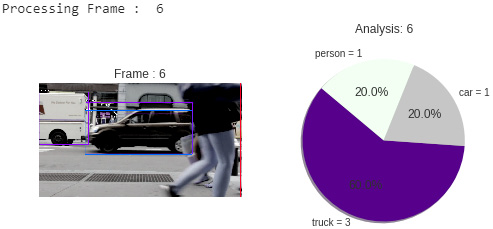Multiple Object Recognition and Detection in Video
Multiple object recognition and detection in static images sounds amazing, but what about detecting and recognizing objects in a video?
You can download any video from the internet and try to detect and recognize all the objects that show up in the video.
The process to follow would be to get every frame of the video and for every frame, detect the corresponding objects and their labels.
Declare the corresponding libraries first:
from imageai.Detection import VideoObjectDetection
from matplotlib import pyplot as plt
The imageai library contains an object that allows the user to apply object detection and recognition to the video:
video_detector = VideoObjectDetection()
We need VideoObjectDetection so that we can detect objects in video. Moreover, Matplotlib is needed to show the detection process for every frame:

Figure 8.6: ImageAI one-frame object detection process
Now we will first need to load the model. You can decide what...






































































